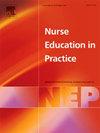Frameworks, methods and indicators for evaluating serious games in nursing education: a scoping review
IF 3.3
3区 医学
Q1 NURSING
引用次数: 0
Abstract
Aim
To identify and confirm the three core elements for evaluating serious games: frameworks, methods and indicators, by integrating the application of serious games in nursing education.
Background
Serious games have great potential in nursing education. Despite extensive research on evaluating serious games, no widely accepted or standardized evaluation in nursing education.
Design
The scope review was conducted according to the Joanna Briggs Institute methodology.
Methods
Nine databases, including Web of Science, PubMed, CINAHL, Embase, Cochrane Library, CNKI, Wanfang, CBM and VIPC Database, were searched for relevant studies from inception to December 2024.
Results
28 studies were included in this paper. There are two main theoretical frameworks regarding evaluation: the TURF usability framework and the TAM usability framework. Evaluation methods were categorized based on timing into three main types: pre-intervention, mid-intervention and post-intervention evaluations. The evaluation indicators were grouped into three main types: knowledge objectives, competency objectives and emotional goals, encompassing 18 indicators. Among them, there were three evaluation indicators related to knowledge objectives, 10 evaluation indicators related to competence objectives and five evaluation indicators related to emotional objectives.
Conclusions
At present, the evaluation of serious games in nursing education requires refinement. A systematic and highly directive evaluation framework is needed. It is imperative to develop a thorough, holistic and dynamic theoretical framework for evaluation based on the educational targets, courses and game types, standardize evaluation tools and techniques and enrich the content of evaluation indicators.
评估护理教育中严肃游戏的框架、方法和指标:范围审查
目的通过整合严肃游戏在护理教育中的应用,确定评估严肃游戏的框架、方法和指标三个核心要素。背景严肃游戏在护理教育中具有巨大的潜力。尽管对严肃游戏的评估进行了广泛的研究,但在护理教育中没有被广泛接受或标准化的评估。根据乔安娜布里格斯研究所的方法进行范围审查。方法检索Web of Science、PubMed、CINAHL、Embase、Cochrane Library、中国知网(CNKI)、万方、CBM、VIPC数据库自建库至2024年12月的相关研究。结果共纳入28项研究。关于评估有两个主要的理论框架:TURF可用性框架和TAM可用性框架。评价方法按时间分为干预前评价、干预中评价和干预后评价三大类。评价指标分为知识目标、能力目标和情感目标三大类,共18个指标。其中,与知识目标相关的评价指标有3个,与能力目标相关的评价指标有10个,与情感目标相关的评价指标有5个。结论目前护理教育中严肃游戏的评价还有待完善。需要一个系统的、高度指导性的评价框架。基于教育目标、课程和游戏类型,构建全面、全面、动态的评价理论框架,规范评价工具和技术,丰富评价指标内容。
本文章由计算机程序翻译,如有差异,请以英文原文为准。
求助全文
约1分钟内获得全文
求助全文
来源期刊

Nurse Education in Practice
NURSING-
CiteScore
5.40
自引率
9.40%
发文量
180
审稿时长
51 days
期刊介绍:
Nurse Education in Practice enables lecturers and practitioners to both share and disseminate evidence that demonstrates the actual practice of education as it is experienced in the realities of their respective work environments. It is supportive of new authors and will be at the forefront in publishing individual and collaborative papers that demonstrate the link between education and practice.
 求助内容:
求助内容: 应助结果提醒方式:
应助结果提醒方式:


